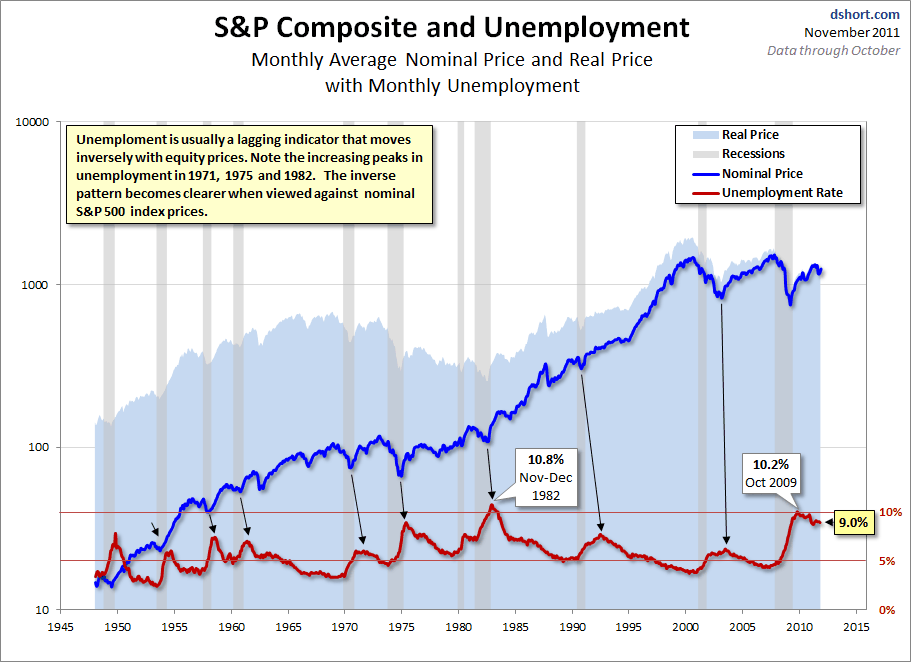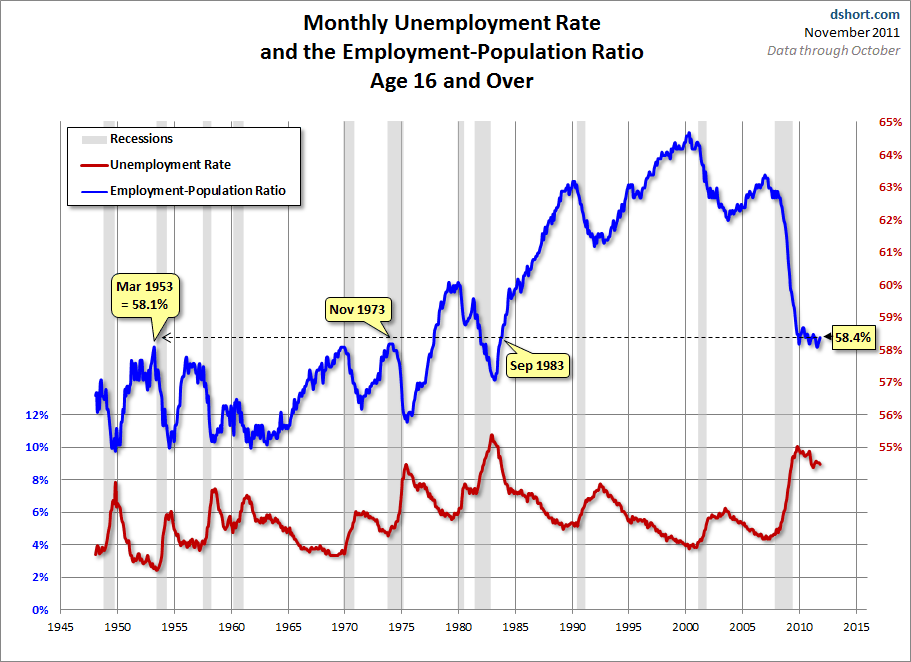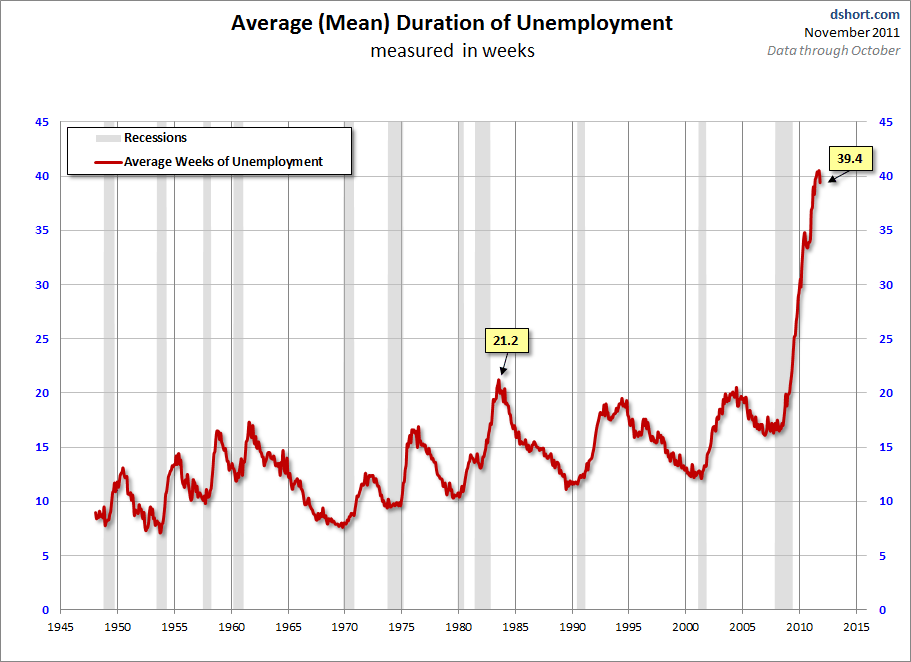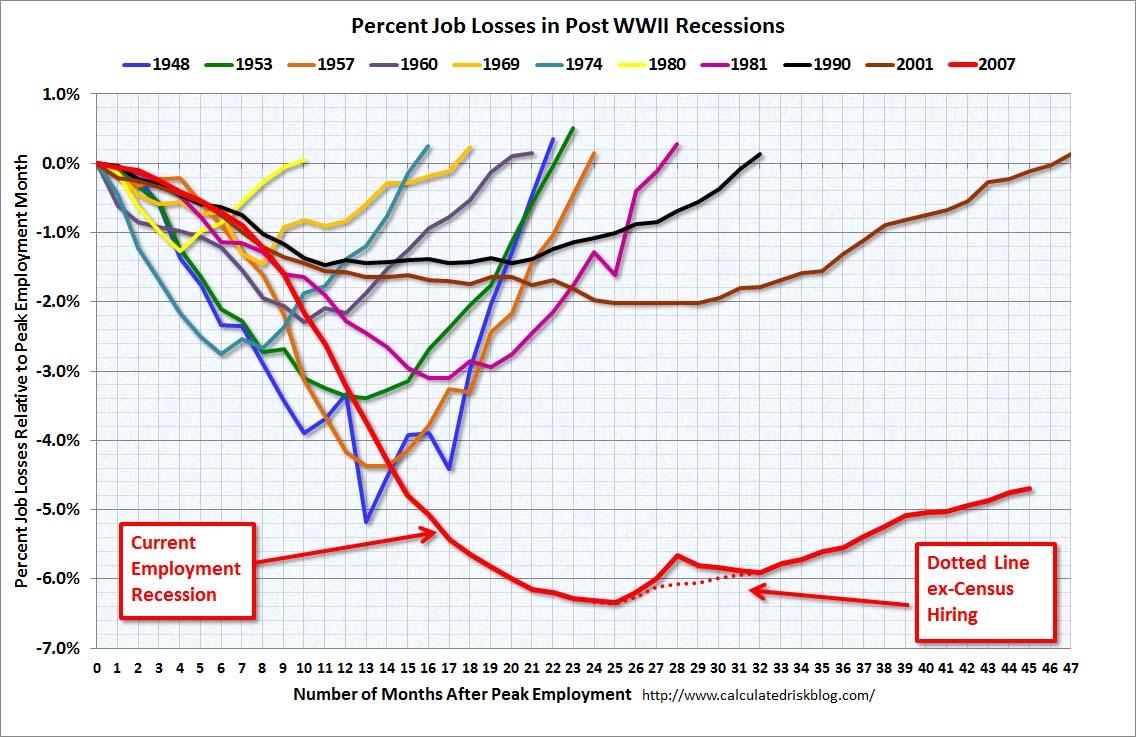Results 1 to 1 of 1
Thread Information
Users Browsing this Thread
There are currently 1 users browsing this thread. (0 members and 1 guests)
-
11-09-2011, 06:59 AM #1Senior Member


- Join Date
- May 2007
- Location
- South West Florida (Behind friendly lines but still in Occupied Territory)
- Posts
- 117,696
5 Charts Clearly Show Just How Major & Depressing Unempl
These 5 Charts Clearly Show Just How Major â and Depressing â the Current Unemployment Situation REALLY Is
Monday, November 7th, 2011
The unemployment rate declined [slightly in October] from 9.1% to 9.0%â¦[but a close look, in chart form, at the pattern of unemployment compared to the S&P 500, the extent of unemployment over 27 weeks duration, the ratio of employed people to those aged 16 and over, the average length of unemployment and how extensive unemployment has been in this most recent recession compared to each of the others over the past 60+ years, is very revealing as to how serious the situation is. It is very depressing, indeed.] Words: 601
So says Doug Short http://advisorperspectives.com which Lorimer Wilson, editor of www.munKNEE.com (Your Key to Making Money!), has further edited ([ ]), abridged (â¦) and reformatted below for the sake of clarity and brevity to ensure a fast and easy read. The authorâs views and conclusions are unaltered and no personal comments have been included to maintain the integrity of the original article. Please note that this paragraph must be included in any article re-posting to avoid copyright infringement.
Short goes on to say, in part:
Chart # 1
The chart below shows: the pattern of unemployment, recessions and both the nominal and real (inflation-adjusted) price of the S&P Composite since 1948.

Unemployment is usually a lagging indicator that moves inversely with equity prices (top chart). Note the increasing peaks in unemployment in 1971, 1975 and 1982. The inverse pattern becomes clearer when viewed against real (inflation-adjusted) S&P Composite, with its successively lower bear market bottoms. The mirror relationship seems to be repeating itself with the current and previous bear markets.
Chart # 2
The second chart (below) shows: the unemployment rate for the civilian population unemployed 27 weeks and over. The October number is 3.8% â down from last monthâs 4.1%. This measure gives an alternative perspective on the relative severity of economic conditions. As we readily see, this metric remains significantly higher than the peak in 1983, which came six months after the broader measure topped out at 10.8%.

Chart #3
The third chart (below) shows: the ratio of the number of employed people to the total civilian population age 16 and over and is an overlay of the unemployment rate and the employment-population ratio.

The inverse correlation between the two series is obvious. We can also see the accelerating growth of two-income households in the early 1980s. The July 2011 ratio was a modern low of 58.1% â a level not seen since the 58.1% ratio of March 1953, when Eisenhower was president of a country of one-income households, the Korean War was still underway, and rumors were circulating that soft drinks would soon be sold in cans. The latest ratio is consistent with levels of the early 1980s.
The employment-population ratio will be interesting to watch going forward. The first wave of Boomers will be a downward force on this ratio. The oldest of them were eligible for early retirement when the Great Recession began, and the Boomer transition to retirement will accelerate over the next several years.
Chart #4
The fourth chart (below) shows: the average length (weeks) of unemploymentâ¦We are perhaps seeing a paradigm shift [as a] â¦result of global outsourcing and efficiencies of technology. The post-recession duration of unemployment has continued to rise, although the October 39.4 is off last monthâs all-time high of 40.5. It had approached a level nearly double the peak in 1983 following the 1981-82 recession.

Chart #5
The last chart (below)â¦shows: the percent of job losses from the peak employment month prior to every recession since 1948 (the earliest monthly unemployment figures collected by the Bureau of Labor Statistics). Note the addition of the dotted-line alternative for the current cycle, which shows unemployment excluding the temporary census hiring.

http://advisorperspectives.com/dshort/u ... Market.php
Related Articles:
[b]1. New Report Confirms that âOccupy Wall StreetâJoin our efforts to Secure America's Borders and End Illegal Immigration by Joining ALIPAC's E-Mail Alerts network (CLICK HERE)


 LinkBack URL
LinkBack URL About LinkBacks
About LinkBacks




 Reply With Quote
Reply With Quote

10% To 27% of 30 Million Non-Citizens Are Registered To Vote
05-15-2024, 10:29 AM in General Discussion